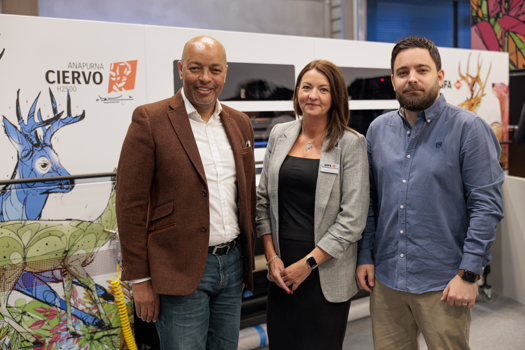
Yet, technology advances so quickly, and with so many concepts being touted as the ‘next big thing’, knowing what’s worth your time, and money, can be difficult. Is NFC about to explode in use, or is augmented reality the future? How could image recognition services alter your market, and what on earth does Google Glass mean for the future of business – and of humanity?
Never one to decline a challenge, PrintWeek set out to assess the current market perception, interest and future potential of key technologies. We spoke to printers, marketers, media analysts and brands already using these technologies, to move past the hype and uncover the facts.
Google Glass
Where’s the technology at now? Of all the technologies competing for attention in the market, Google Glass is perhaps the most striking. It consists of a pair of glasses with a ‘heads-up display’ that enables the wearer to obtain information about the world around them. This could include directions, weather and location data, as well as asking the device to take photos or videos. With the device set for widespread availability in 2014 it could open up a whole new swathe of cross-media opportunities.
Where’s it going? It’s probably fair to say no-one quite knows. It could prove a high-concept, low-uptake technology or it could change the world. Tony Hallett, director at Collective Content, likens it to the iPad when it first hit the market: “It was an amazing moment when you first tried one and you realised what it could do. I think we’re at that stage with Google Glass. People are seeing it in articles or clips on shows but most have not got their hands on it. This means people haven’t had the chance to get their creative juices flowing.” Mark Cody, senior marketing manager for mobile at Tesco, is one of the lucky ones to have tried the device, and for him the potential is clear: “There is no doubt that it has a very exciting future. Will we all be wearing specially adapted glasses in the future? Possibly not, but the ability to overlay relevant contextual information on to the real world has many practical uses.”
How can printers stay ahead of the trend? At present, Google Glass and other wearable forms of technology are just emerging and so there should be time to track their growth and potential. Creative technologist at Reading Room, Andrew Larking, says the important thing with any form of emerging technology is to stay aware of its growth and not be afraid to try it out. “It’s great to mess about with technology and you have to be brave and accept failure because at least you will have learnt something,” he says.
Augmented reality
Where’s the technology at now? Use of augmented reality (AR) is growing all the time. It enables a user to view a piece of literature, such as a magazine page, through their smartphone or tablet – usually via a dedicated app – which overlays more information. For example, the 2014 Ikea catalogue uses an AR feature to enable customers to see how an item of furniture would fit into their home.
Ikea UK marketing manager Peter Wright says the numbers prove that including the AR functionality within its print catalogue was worth the effort: “We know that 54% of our customers are accessing their email from a handheld device. Mobiles are becoming the primary platform from which to access information. For Ikea, incorporating AR into our catalogue wasn’t a gimmick; it was a way of providing people with a tool that gives them the opportunity to try before they buy.”
Another major brand using AR is Tesco. It has been using the technology within its own-brand magazine for a while now and Cody claims engagement has been high. “We are consistently seeing significantly higher than average click-through rates linking to rich and engaging content,” he says. “For example, you could be reading a recipe for wild mushrooms from the magazine, and then, by adding an AR element, we can take the customer to a cook-along recipe or allow them to add the ingredients
to their shopping basket.”
Where’s it going? As the Ikea and Tesco use proves, AR is on the cusp of becoming mainstream. The real driving force of AR is the massive uptake of smartphones and tablets and this is only going to grow in future. “Mobile devices are the gateway to our digital lives,” says managing director of AR firm Linkz-IM, Andrew Perry-Smith. “It’s now very natural to use a mobile to interact with the world around you.” As such, services like AR look destined for strong growth in the future.
How can printers stay ahead of the trend? Robert Padmore, head of digital media at the St Ives Group, urges printers to start swatting up on AR as it is one area where clients will soon start expecting their partners to have expertise and the capability to deliver: “Clients are demanding more value from their supplier partners. Businesses with this expertise can deliver tailored content for their clients and will lead the way.”
Near-field communication
Where’s the technology at now? Near-field communication (NFC) has been on the up in recent years with Transport for London accepting NFC payments for bus journeys from NFC-enabled bank cards and many high-street stores now using Visa’s Paywave service. Estate agent Winkworth has started using NFC to provide housing information from digital ‘keyrings’ in its offices, while Queen Mary University in London has installed posters on campus with NFC technology to provide additional information. However, with Apple refusing to put NFC in its iPhones, millions of phone owners cannot use the technology, which could be a serious stumbling block.
Where’s it going? NFC is certainly growing. While Apple may be holding out, other phone giants, such as Samsung, are busy incorporating it into their phones. Sam Amrani, founder of NFC provider Tamoco, believes the market is ripe for growth in 2014: “We find the understanding of NFC among media owners is quite high. For brands it’s more of a learning curve, but once they understand it they want to use it,” he says. However, others such as Timon Colegrove, director of Hunts Paper & Pixels, are unsure what role this technology will play in the future: “NFC definitely has uses for payments in credits cards, but it means you have to hold the phone near the image and that has to have a chip embedded... I’m not sure how relevant it will be for printers.”
How can printers stay ahead of the trend? Despite these differences, consultant analyst Rob Curran from Reading Room argues that printers must keep track of developments in NFC as it has the potential to grow in use rapidly: “When things do become popular, it’s often the case that some companies appear to be very quick off the mark and able to hit the ground running. But it’s because they’ve been experimenting with the technology in the background.”
Image recognition technology
Where’s the technology at now? While still a nascent service, image recognition (IR) technology could have huge potential. It enables consumers to scan an image with a phone or tablet and then have additional content delivered to their device – perhaps through a link to an advertiser’s website or a catalogue page with similar items. (See how it works by downloading the Linkz app for your Apple or Android smartphone and scanning the image, left.) The really exciting thing about IR is that because the necessary data and functionality is stored on the user’s device or in web-based database, rather than in the print itself, it means any piece of print can be made interactive, including retrospectively – a mind-boggling concept.
Where’s it going? Numerous reports have touted a big future for IR, with online powerhouse eBay estimating sales of £97.1m in 2014 based on the technology. Clearly this is something that printers and marketers could see big benefits from. Furthermore, with Apple holding off on NFC, some experts, such as Perry-Smith from Linkz-IM, believe the phone giant is instead more likely to start pushing built-in IR technology in its future devices. If it did, the technology has the potential to really take off in a big way.
How can printers stay ahead of the trend? Hunts’ Colegrove is one printer actively seeking to start using IR services: “We’ve not done it yet but it is something I want to do, and once one client gives it a go and we have a case study then we will be off.” He argues a proactive attitude towards technologies such as IR is a must for printers: “If nothing else, you need to demonstrate to clients and prospects that, even if they don’t want these kinds of technologies yet, they are dealing with tech-savvy people.”









